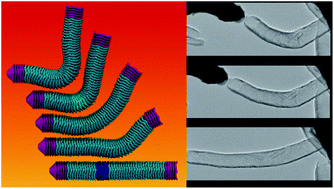A reversible strain-induced electrical conductivity in cup-stacked carbon nanotubes†
Abstract
We have used in situ current–voltage measurements of cup-stacked

a Faculty of Engineering, Shinshu University, 4-17-1 Wakasato, Nagano 380-8553, Japan
b Department of Physics, Applied Physics, and Astronomy and Department of Material Science and Engineering, Rensselaer Polytechnic Institute, 110 Eighth Street, Troy, NY 12180, USA
c Department of Materials Science and Technology, Nagaoka University of Technology, 1603-1, Kamitomioka, Nagaoka, Niigata, Japan
d Center for Nanophase Materials Sciences and the Computer Science & Mathematics Division, Oak Ridge National Laboratory, One Bethel Valley Road, Oak Ridge, Tennessee 37831-6367, USA
e Research Center for Exotic Nanocarbons (JST), Shinshu University, Wakasato 4-17-1, Nagano 380-8553, Japan
f Department of Physics, Department of Chemistry, Department of Materials Science and Engineering & Center for 2-Dimensional and Layered Materials, The Pennsylvania State University, 104 Davey Lab., University Park, PA 16802-6300, USA
We have used in situ current–voltage measurements of cup-stacked

 Please wait while we load your content...
Something went wrong. Try again?
Please wait while we load your content...
Something went wrong. Try again?
T. Hayashi, T. C. O'Connor, K. Higashiyama, K. Nishi, K. Fujisawa, H. Muramatsu, Y. A. Kim, B. G. Sumpter, V. Meunier, M. Terrones and M. Endo, Nanoscale, 2013, 5, 10212 DOI: 10.1039/C3NR01887C
To request permission to reproduce material from this article, please go to the Copyright Clearance Center request page.
If you are an author contributing to an RSC publication, you do not need to request permission provided correct acknowledgement is given.
If you are the author of this article, you do not need to request permission to reproduce figures and diagrams provided correct acknowledgement is given. If you want to reproduce the whole article in a third-party publication (excluding your thesis/dissertation for which permission is not required) please go to the Copyright Clearance Center request page.
Read more about how to correctly acknowledge RSC content.
 Fetching data from CrossRef.
Fetching data from CrossRef.
This may take some time to load.
Loading related content
